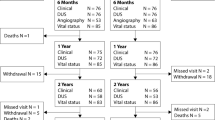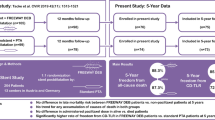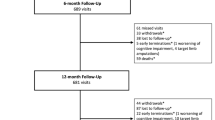Abstract
Purpose
To report the 3-year results of the MAJESTIC first-in-human study of the Eluvia Drug-Eluting Vascular Stent System for treating femoropopliteal artery lesions.
Methods
The prospective, single-arm, multicenter clinical trial enrolled 57 patients with symptomatic lower limb ischemia (Rutherford category 2, 3, or 4) and lesions in the superficial femoral artery or proximal popliteal artery. Mean lesion length was 70.8 ± 28.1 mm, and 46% of lesions were occluded. Efficacy measures at 2 years included primary patency, defined as duplex ultrasound peak systolic velocity ratio of ≤2.5 and the absence of target lesion revascularization (TLR) or bypass. Safety monitoring through 3 years included adverse events and TLR.
Results
Primary patency was estimated as 83.5% (Kaplan–Meier analysis) at 24 months, and 90.6% (48/53) of patients maintained an improvement in Rutherford class. At 36 months, the Kaplan–Meier estimate of freedom from TLR was 85.3%. No stent fractures were identified, and no major target limb amputations occurred.
Conclusion
MAJESTIC results demonstrated long-term treatment durability among patients whose femoropopliteal arteries were treated with the paclitaxel-eluting Eluvia stent.
Level of Evidence
Level 2b, cohort study





Similar content being viewed by others
References
Duda SH, Bosiers M, Lammer J, et al. Drug-eluting and bare nitinol stents for the treatment of atherosclerotic lesions in the superficial femoral artery: long-term results from the SIROCCO trial. J Endovasc Ther. 2006;13:701–10.
Lammer J, Bosiers M, Zeller T, et al. First clinical trial of nitinol self-expanding everolimus-eluting stent implantation for peripheral arterial occlusive disease. J Vasc Surg. 2011;54:394–401.
Zhao HQ, Nikanorov A, Virmani R, Jones R, Pacheco E, Schwartz LB. Late stent expansion and neointimal proliferation of oversized Nitinol stents in peripheral arteries. Cardiovasc Intervent Radiol. 2009;32:720–6.
Costa MA, Simon DI. Molecular basis of restenosis and drug-eluting stents. Circulation. 2005;111:2257–73.
Wiskirchen J, Schober W, Schart N, et al. The effects of paclitaxel on the three phases of restenosis: smooth muscle cell proliferation, migration, and matrix formation: an in vitro study. Invest Radiol. 2004;39:565–71.
Iida O, Uematsu M, Soga Y, et al. Timing of the restenosis following nitinol stenting in the superficial femoral artery and the factors associated with early and late restenoses. Catheter Cardiovasc Interv. 2011;78:611–7.
Bausback Y, Willfort-Ehringer A, Sievert H, et al. Six-month results from the initial randomized study of the ranger paclitaxel-coated balloon. J Endovasc Ther. 2017;24:459–67.
Tepe G, Laird J, Schneider P, et al. Drug-coated balloon versus standard percutaneous transluminal angioplasty for the treatment of superficial femoral and/or popliteal peripheral artery disease: 12-month results from the In PACT SFA randomized trial. Circulation. 2015;131:495–502.
Schroeder H, Meyer DR, Lux B, Ruecker F, Martorana M, Duda S. Two-year results of a low-dose drug-coated balloon for revascularization of the femoropopliteal artery: outcomes from the ILLUMENATE first-in-human study. Catheter Cardiovasc Interv. 2015;86:278–86.
Rosenfield K, Jaff MR, White CJ, et al. Trial of a paclitaxel-coated balloon for femoropopliteal artery disease. N Engl J Med. 2015;373:145–53.
Dake MD, Ansel GM, Jaff MR, et al. Durable clinical effectiveness with paclitaxel-eluting stents in the femoropopliteal artery: 5-year results of the zilver PTX randomized trial. Circulation. 2016;133:1472–83 discussion 1483..
Dake MD, Ansel GM, Jaff MR, et al. Sustained safety and effectiveness of paclitaxel-eluting stents for femoropopliteal lesions: 2-year follow-up from the Zilver PTX randomized and single-arm clinical studies. J Am Coll Cardiol. 2013;61:2417–27.
Müller-Hülsbeck S. Eluvia peripheral stent system for the treatment of peripheral lesions above the knee. Expert Opin Drug Deliv. 2016;13:1639–44.
Müller-Hülsbeck S, Keirse K, Zeller T, Schroe H, Diaz-Cartelle J. Twelve month results from the MAJESTIC trial of the Eluvia Paclitaxel-Eluting Stent for treatment of obstructive femoropopliteal disease. J Endovasc Ther. 2016;23:701–7.
Rutherford RB, Baker JD, Ernst C, et al. Recommended standards for reports dealing with lower extremity ischemia: revised version. J Vasc Surg. 1997;26:517–38.
Powell RJ, Jaff MR, Schroe H, Benko A, Diaz-Cartelle J, Muller-Hulsbeck S. Stent placement in the superficial femoral and proximal popliteal arteries with the innova self-expanding bare metal stent system. Catheter Cardiovasc Interv. 2017;89:1069–77.
Stone GW, Teirstein PS, Meredith IT, et al. A prospective, randomized evaluation of a novel everolimus-eluting coronary stent: the platinum (a prospective, randomized, multicenter trial to assess an everolimus-eluting coronary stent system [Promus element] for the treatment of up to two de novo coronary artery lesions) trial. J Am Coll Cardiol. 2011;57:1700–8.
Wilson GJ, Huibregtse BA, Stejskal EA, et al. Vascular response to a third generation everolimus-eluting stent. EuroIntervention. 2010;6:512–9.
Gasior P, Cheng Y, Valencia AF, et al. Impact of fluoropolymer-based paclitaxel delivery on neointimal proliferation and vascular healing: a comparative peripheral drug-eluting stent study in the familial hypercholesterolemic swine model of femoral restenosis. Circ Cardiovasc Interv. 2017;10:e004450.
Laird JR, Schneider PA, Tepe G, et al. Durability of treatment effect using a drug-coated balloon for femoropopliteal lesions: 24-month results of IN PACT SFA. J Am Coll Cardiol. 2015;66:2329–38.
Acknowledgements
The authors thank the following Boston Scientific employees for their assistance: Lieve Cornelis, Lisa Melchior, and Teri Takle-Flach for clinical program management, H. Terry Liao, PhD, for statistical analysis, and Elizabeth J. Davis, PhD, for medical writing. This study was funded by Boston Scientific Corporation (Marlborough, MA).
Author information
Authors and Affiliations
Corresponding author
Ethics declarations
Conflict of interest
Stefan Müller-Hülsbeck serves as a consultant for Boston Scientific and has received consulting fees, speaker honorarium, and support for accommodation and traveling when presenting BSC-related data. Thomas Zeller serves as a consultant for Boston Scientific, Cook, Medtronic, W. L. Gore, Veryan, Spectranetics, Trireme, and Terumo and has received consulting fees, speaker honoraria, and support for accommodation and traveling from the same companies. Herman Schroë serves as a consultant for Boston Scientific and has received consulting fees, speaker honorarium, and support for accommodation and traveling when presenting BSC-related data. Juan Diaz-Cartelle is an employee of and owns stock in Boston Scientific Corporation. Koen Keirse declares no conflicts of interest.
Ethical Approval
All procedures performed in studies involving human participants were in accordance with the ethical standards of the institutional and/or national research committee and with the 1964 Helsinki Declaration and its later amendments or comparable ethical standards.
Informed Consent
Informed consent was obtained from all individual participants included in the study.
Rights and permissions
About this article
Cite this article
Müller-Hülsbeck, S., Keirse, K., Zeller, T. et al. Long-Term Results from the MAJESTIC Trial of the Eluvia Paclitaxel-Eluting Stent for Femoropopliteal Treatment: 3-Year Follow-up. Cardiovasc Intervent Radiol 40, 1832–1838 (2017). https://doi.org/10.1007/s00270-017-1771-5
Received:
Accepted:
Published:
Issue Date:
DOI: https://doi.org/10.1007/s00270-017-1771-5




